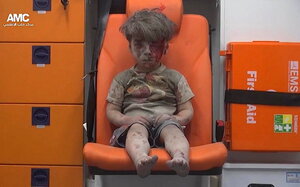Pulling kids from war’s rubble
Global reaction to children in conflicts – as soldiers, refugees, or among the injured – has improved as more nations presume innocence for the youngest and most vulnerable.

In an image from a video provided by the Syrian anti-government activist group Aleppo Media Center (AMC), 5-year-old Omran Daqneesh sits in an ambulance after being pulled out of a building hit by an airstrike, in Aleppo, Syria, Aug. 17.
Aleppo Media Center via AP
Within days of each other in August, two news items about children in conflicts caught the world’s attention. And each in a different way offered a reminder of why focusing on their plight in war is a necessary path to peace.
One was the image of a five-year-old Syrian boy, Omran Daqneesh, sitting with a bedazzled look in an ambulance after being pulled from a house in Aleppo bombed by either a Syrian or Russian jet.
The other item was about a suicide bomber, believed to be around 13 and trained by Islamic State (IS), who killed 51 people at a wedding in Turkey. Nearly half of those killed by the child soldier were children themselves.
These two young people – an injured refugee and a military perpetrator – were at opposite ends of warfare. Yet in the eyes of much of the world, they are each a victim deserving protection. That is because of the rising scrutiny of children in conflict, not only in the Middle East but also from Nigeria to the Philippines, backed up by a near-universal presumption of their innocence.
The most widely ratified treaty on human rights is the UN Convention on the Rights of the Child. Because of that 1989 pact and an increasing number of other efforts, the world is more active than ever in helping children in war – and using that issue to end conflicts.
UNICEF, for instance, reported in June that 9 out of 10 refugee or migrant children arriving in Europe from North Africa were unaccompanied. And it has recorded thousands of child soldiers recruited in South Sudan, Yemen, Afghanistan, and other places, as well as by IS.
In a sign of this new attention, the 2016 Summer Games in Rio included young refugees under the official Olympic flag. Many, such as 18-year-old Syrian swimmer Yusra Mardini, had fled war.
Of particular concern is the strategy by IS to forcibly recruit, indoctrinate, and train children as fighters to create a generation of terrorists even if the group loses its territory in Syria and Iraq.
Last year, an estimated 1,100 children under age 16 – dubbed by the group as “lion cubs of the caliphate” – were part of IS forces, according to the Syrian Observatory for Human Rights. A retired Canadian military general, Roméo Dallaire, has launched a training program aimed at helping Western-backed forces in that struggle engage with the IS child soldiers and return them to their families. The idea, while a difficult task, is yet another sign of the global awakening to the need to protect the most innocent – and innocence itself – from war’s harm.

